2.
GHANA
Ghana to introduce new rules on wood procurement
Ghana is soon to introduce a new Legislative Instrument
(LI) for the procurement of wood products by public
sector institutions for all government projects in the
country.
Analysts say that the new law will require the use of wood
products for public sector projects from verified legal
sources and will also redefine export procedures in
relation to verifying the legal source of wood products
destined for export markets.
The new LI is to ensure total protection of the country¡¯s
forest which the government says has been depleted over
the years as a result of activities of illegal chainsaw
operators.
This information was alluded to by the Deputy Minter of
Lands and Natural Resource, Mr. Henry Ford Kamel, at a
Forum on Natural Resources and Environmental
Governance in Ghana.
The Minister voiced concern over the continuing illegal
logging taking place in the country¡¯s scarce forest
resources.
Forestry Commission seeks independent monitor for
the VPA
The Forestry Commission of Ghana has called for
expressions of interest for the engagement of an
Independent Monitor under the Voluntary Partnership
Agreement (VPA).
This is in line with the VPA which requires the
establishment of a Joint Monitoring and Review
Mechanism (JMRM), a body that will conduct periodic
reviews to ensure the effective implementation of the
VPA.
The appointment of an Independent Monitor aims at
providing assurances to all interested parties, that the
Legality and Assurance System (LAS) of the agreement is
being observed.
Among the key responsibilities of the Independent
Monitor are;
• Assessing the implementation and effectiveness
of LAS,
• Conducting field investigations on the relevant
work of the forestry regulatory agencies,
• Identifying and documenting system failures, and
recommending corrective action,
• Assessing the adequacy of data management
systems supporting the LAS,
and
• Assessing the effectiveness of license verification
procedures on entry of wood products into the
EU,
The service of the Independent Monitor is expected to
cover a period of 4 years in the first instance. Ghana
became the first timber-producing country to sign a
Voluntary Partnership Agreement with the European
Union (EU) in Nov.2009.
VPA to support forestry sector reform
Officials of the Ministry of Lands and Natural Resources
and the European Union have concluded a 3-day meeting
in Accra to deliberate on the Voluntary Partnership
Agreement.
A report from the ministry indicated that the Government
of Ghana sees the VPA as a means to support forestry
sector reform and to strengthen its regulatory capacity in
order to reduce revenue loss and environmental
degradation that result from illegal logging.
Bank of Ghana announces interest rate cut
The Monetary Policy Committee (MPC) of the Bank of
Ghana, has cut the policy rate by 0.5 percent to 12.5
percent from 13 percent, citing low inflation and an
improved economic environment.
The Governor of the Bank of Ghana, Mr. Amissah-Arthur,
said the MPC was committed to price stability to provide a
supportive environment for growth, adding the Bank was
confident that the annual inflation target of nine percent
was achievable.
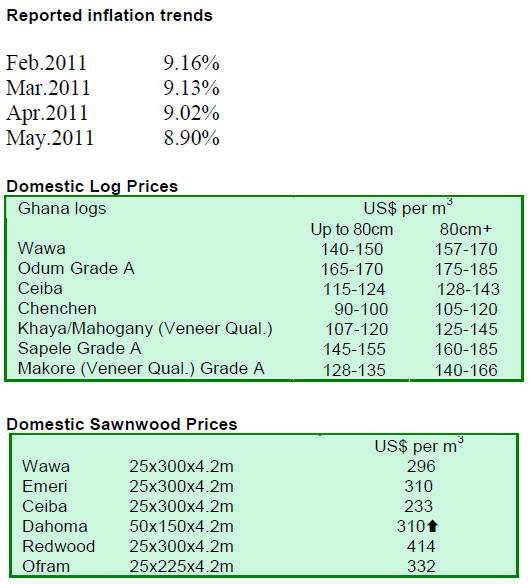
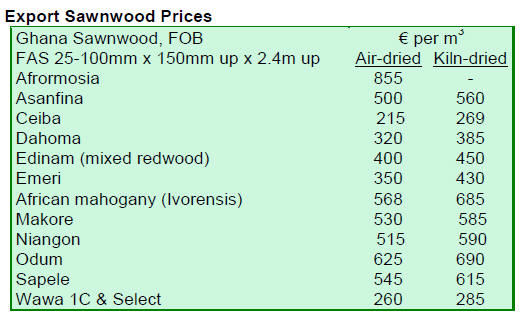
3.
MALAYSIA
Industry urged to develop code of conduct
The Ministry of Plantation Industries and Commodities
said that Malaysian timber businesses should lend their
support to the introduction of a code of conduct for the
industry as global consumers are becoming more aware of
issues related to sustainability and the environment.
The minister added that the code of conduct for the timber
industry could draw upon the experiences of the local
palm oil and mining industries and those of foreign timber
associations which have successfully implemented their
own codes.
The ministry took cognizance of the importance of an
industry code of conduct as the timber industry continues
to address various concerns such as illegally harvested
timber, deforestation, forest conversion and native land
rights.
Malaysia is currently working to position itself as an
ethical and major producer of timber and timber products.
As such, 4.65 million ha. of natural forest has been
certified under the Malaysian Timber Certification
Scheme in collaboration with the Programme for
Endorsement of Forest Certification Scheme.
This is in addition to 173,000 ha. of natural forest and
31,000 ha. of forest plantations certified under the Forest
Stewardship Council scheme.
Of particular concern to Malaysian timber exporters is the
US Lacey Act amended in May 2008 to ban the import of
illegally harvested timber and timber products into the US.
Similar regulations have been adopted in the European
Union and will come into force in 2013 thus a code of
conduct for the local timber industry will be a catalyst to
help to address the myriads of issues faced by the industry
in the international marketplace.
Producers cautious because of mixed market signals
Prices of Malaysian timber and timber products remain
stable. Sarawak based loggers are still trying to overcome
river transportation problems linked to the Bakun Dam.
However, this is beginning to have a marginal effect on
timber processors in Peninsular Malaysia who are
increasingly looking overseas for their raw material
supply, in particularly from Africa, Australia and New
Zealand.
While the plywood sector is enjoying an increase in orders
from Japan, the combination of the European debt crisis
and uncertainty in the US economy has brought about an
element of caution in the local timber market. Timber
processors are wary of being caught with excessive
inventory as at the beginning of the global economic
slowdown in 2009.
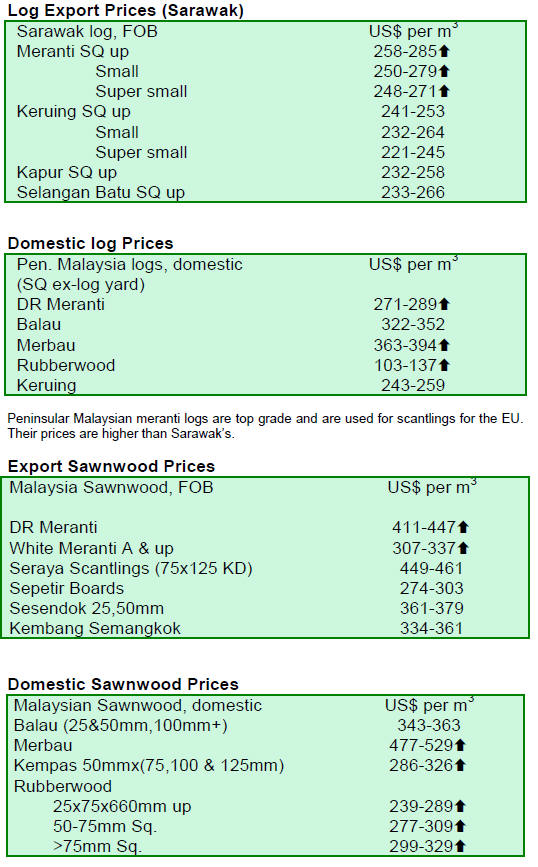
4.
INDONESIA
Increasing demand for verification and
certification
services creates business opportunities
California-based Scientific Certification Systems (SCS)
announced that they will be setting up an office in Jakarta
in direct response to an increasing demand for verification
and certification services from the Indonesian timber
industry.
PT Scientific Certification Systems Indonesia (PT-SCS),
as it will be known, will offer services in Forest
Stewardship Council (FSC) Chain of Custody
Certification and Forest Management Certification, in
Indonesia.
PT-SCS will also offer ¡®LegalHarvest¡¯ verification
services, and is in the process of becoming an accredited
SVLK (Timber Legality Assurance System) service
provider for the Indonesian mandatory national standard in
timber certification.
In addition, PT-SCS will offer forest carbon offset
verification services. It has already begun to verify
Indonesia's first REDD project to the Voluntary Carbon
Standard (VCS).
Private consortium raises cash for carbon projects
A major Australian banking and financial services
provider - the Macquarie Group, the International Finance
Corporation (IFC), an affiliate of the World Bank and a
forest management firm said they had raised $25 million
for forest carbon projects in developing countries.
The Macquarie Group¡¯s firm, BioCarbon Group, said it
had agreed to the terms and conditions of the investment
plan, with fellow investors the IFC and U.S.-based Global
Forest Partners LP for total equity financing package of
$25 million.
The Macquarie Group is currently developing 3 REDD
projects in Indonesia in partnership with the global
conservation group Fauna & Flora International, and is
looking for room for expansion. BioCarbon will be the
financial vehicle for these upcoming projects.
The first recipient of the new investment funding is
set to
be a 40,000 ha. (100,000 acre) project in Kapuas Hulu in
West Kalimantan. Most of the project is on carbon-rich
peat swamp forest.
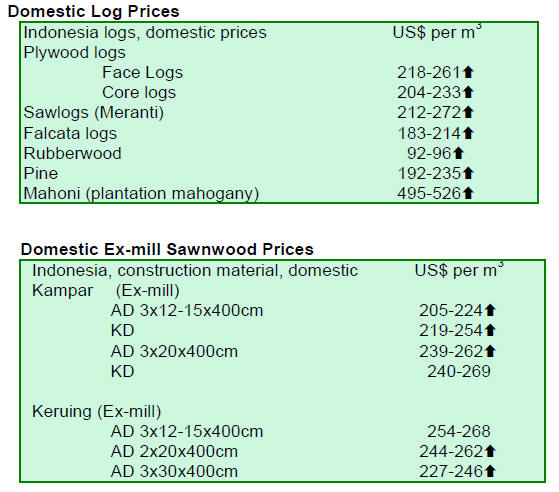
5. MYANMAR
Timber market lacking direction
The market situation during the first weeks of July was
similar to that of the previous month with a quiet Pyinkado
market, while Gurjan (Kanyin) continues to enjoy a brisk
trade.
New price structure for Gurjan
The Myanmar Timber Enterprise, the trading arm of the
Ministry of Forestry has announced new price structures
for Gurjan.
During the current financial year, 2010-11, prices
for
Gurjan (Kanyin) logs harvested from the Monywa-
Momeik-Mawlike-Mabein areas will now be priced at
US$ 440 per hoppus ton (the previous price was US$ 390).
Logs from all other areas will be priced at US$425
(previously US$ 375).
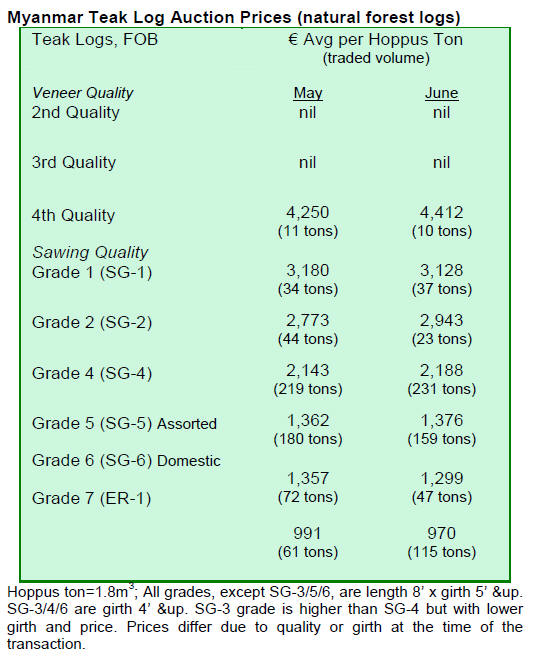
Environmental concerns driving end-users away
from
natural teak
Analysts in close contact with traders in Taiwan P.o.C and
Thailand say that furniture manufacturers and other highend
teak product producers are showing a gradual
preference for plantation teak over teak from natural
forests.
Environmental concerns, trade sanctions and certification
constraints are quoted as the reasons driving this change.
It appears that teak from Myanmar is now only being used
extensively for flooring production. This news is very
depressing for those manufacturers who have a marked
preference for natural teak.
Calls to limit teak log exports
Some analysts feel that reduction in harvested volumes
and a reduction in teak log exports should be considered
while the negative impressions in the market of the
management of natural teak forests in Myanmar are
addressed.
6. INDIA
Economists suggest export growth
could slow
During fiscal 2010/11 India made good progress in
international trade. During May 2011 imports grew by
54% to US$ 40.9 billion and exports by 57% to US$25.9
billion. Both imports and exports have recorded double
digit growth continuously for 13 months.
However, despite the good May data some economists
are
suggesting that the level of India's exports may see a
period of decline because of rising inflation and interest
rates, both of which would undermine the competitive
edge Indian products currently have in world markets.
A recently concluded survey said that exporters are
becoming less optimistic about the future. The removal of
the interest rate subsidy for exporters in March this year
has affected export prices, even though the companies
have been trying hard to absorb the negative impact of the
subsidy removal.
With oil prices continuing to climb exporters
anticipate a
decline in demand in many Asian countries.
Exporters react to changes in tax refund system
The government's decision to only extend the tax refund
system for exporters for three months has angered many
exporters.
There is a plan to replace this tax refund scheme
with a
new tax structure but details of this have not yet been
finalised.
The current scheme, in operation until later this
year,
allows for the reimbursement of customs duty paid on an
imported input used in the export product. This scheme
has been in place for over a decade and covers around half
of the exports from India.
Ganhidham is home to many timber industries
Imports of timber through Kandla have been increasing as
the district of Kutch has good port facilities and wood
based industries have been permitted with Gandhidham as
the central point.
Estimates put the number of workers employed in the
sector in Ganhidham at around 25000 in approximately
500 wood based factories of which 65 are peeling, slicing
and plywood units.
Total quantity of timber imported here during
2010~11
Was37, 28,256 cubic metres consisting of hardwoods and
softwoods. But, in terms of quantity Kandla is the number
one port for imports of timber.
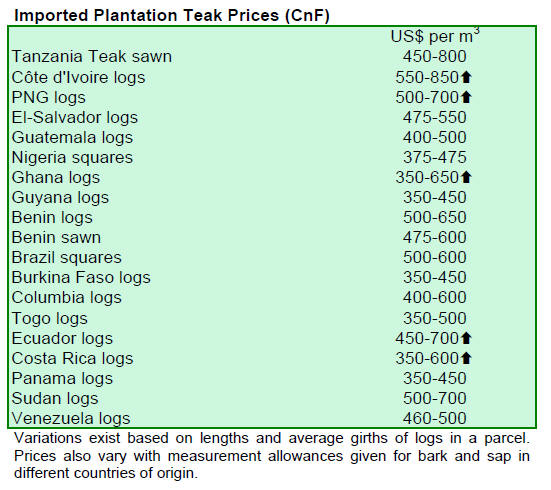
Demand from Europe, USA and Middle East for teak and
other hardwoods remains steady.
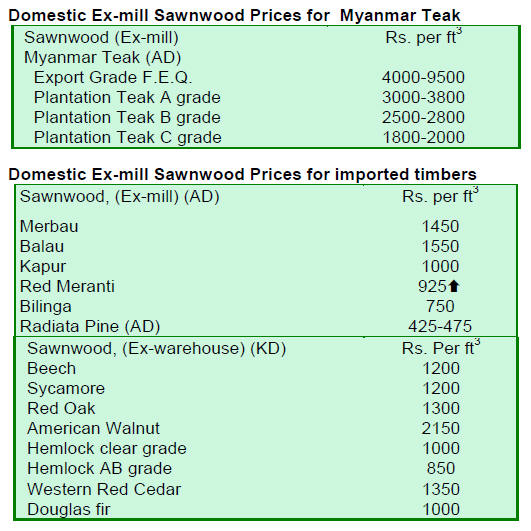
7. BRAZIL
Domestic consumer awareness
programme launched
Concerns have been raised on the level of wood waste
generated by the timber industry due to inefficient
harvesting and processing.
Brazil reportedly consumes around 17 million cu.m
of
wood per year and the highest consumption is in the state
of Sao Paulo.
Harvests of tropical timber from the Amazon are in
the
region of 2.5 mil. cu.m annually. It is estimated that only
around 1.5 mil. cu.m is used for construction, furniture
manufacturing and other uses, the balance is unaccounted
for and assumed to be mainly harvesting and processing
resides.
In Sao Paulo a consumer awareness programme has
been
launched called ¡°Wood is Legal¡±. This seeks to encourage
domestic consumers to purchase wood from proven legal
sources and to promote the use of legally sourced timber
in construction.
The Brazilian authorities recognize that, at
present, it is
difficult to separate wood that comes from forests
managed to approved standards and that from illegal
logging.
By encouraging timber companies to commit
themselves
to reduce waste and to adopting more efficient
technologies and at the same time encouraging consumers
to demand to know the origin of the timber they purchase,
the level of illegal harvesting can be reduced and the level
of processing efficiency can be improved.
Intensified action to combat illegal logging
Deforestation in the Amazon fell in May compared to
April 2011. According to the National Institute for Space
Research (INPE), deforested areas, captured by satellites
that monitor the bioma, recorded a decrease of more than
200 sq. km in the area deforested.
According to the Brazilian Ministry of Environment
this
recorded drop in the area deforested is a consequence of
tough measures adopted in March and April by the Crisis
Office formed by the Brazilian Institute of Environment
and Renewable Natural Resources (IBAMA), the Federal
Police, the Federal Highway Police, the National Security
Force and the Army.
The activities of this office resulted in an
intensification of
efforts to combat illegal logging and in patrolling the
highways to detect and stop the transport of illegal timber.
The number of satellite deforestation alerts issued doubled
as the sky was clear and the satellites were able to more
accurately capture the images of deforestation in the
Amazon.
IBAMA allocated 400 inspectors in Mato Grosso alone
where the severe deforestation was recorded by the
monitoring system. This state continues to account for the
highest rates of deforestation.
In May, 94 sq. km. were deforested in Mato Grosso
equivalent to 35% of the total Amazon deforestation the
second worst level was recorded in the state of Rondônia
where the rate was around 67 sq. km. INPE reported that
in May 2011 the rate of deforestation in the Amazon
exceeded the levels in May in 2009 and 2010.
Uruguay emerges as the main market for Brazilian
furniture
Data for furniture exports for the first 5 months of the year
reveal that Uruguay became the main destination of
furniture exports from the state of Rio Grande do Sul, in
Southern Brazil, surpassing the level of exports to the
United Kingdom and Argentina.
During the same period in 2010, exports to the UK
and
Argentina reached US$ 12.6 million and US$ 8.3 million,
respectively, while exports to Uruguay were just US$ 8.0
million. But in January to May 2011, exports to the United
Kingdom and Argentina dropped 27.4% and 22.3%,
respectively, while exports to Uruguay grew 17.4%.
Furniture export performance slips
The Ministry of Development Industry and Foreign Trade
has reported that furniture exports from Rio Grande do
Sul, in the first 5 months of the year fell almost 6%
compared to the same period last year.
Nevertheless, Rio Grande do Sul maintains its
second
place in the ranking of Brazilian furniture exporting states
just behind the state of Santa Catarina.
Overall, Brazilian furniture exports fell almost 1%
in the
period January to May 2011 compared to the same period
last year. While the furniture export performance to-date is
disappointing, it is expected to grow 4% this year and in
2012 according to projections from the Center for
Industrial Studies.
Brazil currently accounts for 2% of the world furniture
production, occupying 13th position in the ranking of
largest furniture producers and 30th in the ranking of
exporters. The four largest furniture exporters in the world
continue to be China, Italy, Germany and Poland.
Inward looking furniture sector about to change
The Brazilian furniture industry has traditionally been
dependant on the domestic market and the level of
furniture imports has generally been low.
For furniture exporters around the world it has
been an
uphill struggle to penetrate the Brazilian market for
furniture but, as Brazil will host both the 2014 FIFA
World Cup and the 2016 Olympics, domestic furniture
manufacturers and traders see a bright future for the
sector. Demand for furniture especially for the hospitality
sector for hotel refurbishment is expected to grow.
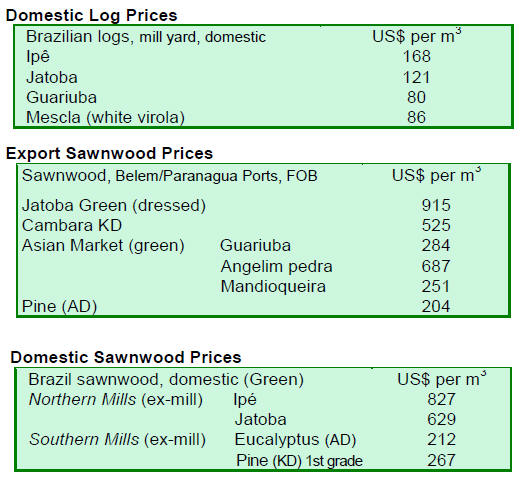
8. PERU
Targetting US$5 billion investment
for the Amazon
Peru is to establish an Investment Promotion Agency for
the Amazon. This agency will seek and oversee
investments in the Amazon regions of Loreto, Ucayali,
Amazonas, San Martin and Madre de Dios and aims to
secure investment commitments from the private sector
and has targeted investments of US$ 5 billion over 12
months.
It is anticipated that much of the investment will
be in the
forestry and timber processing sectors.
The agency will also aim to integrate commercial
investments with projects to support local economies and
communities.
Mexican industry seeks early approval of FTA
with Peru
Fifteen Mexican business associations, including some
timber industry associations, have asked the Mexican
Senate to endorse the Free Trade Agreement between Peru
and Mexico as soon as possible.
According to Peru¡¯s deputy Minister of Foreign
Trade this
FTA will be ratified by Congress and could take effect as
early as late July.
The FTA signed between Peru and Mexico, which
deepens
the Economic Complementation Agreement No. 8 (ACE
8), will open the way for improved trade of some 12,000
Peruvian products, almost twice the number under the
ACE8.
Indutrial sectors in Peru that will benefit include
Peruvian
textiles and wood products. Mexico is a market consisting
of more than 112 million people and in 2010 Peru's
exports to Mexico totalled US$ 286 million.
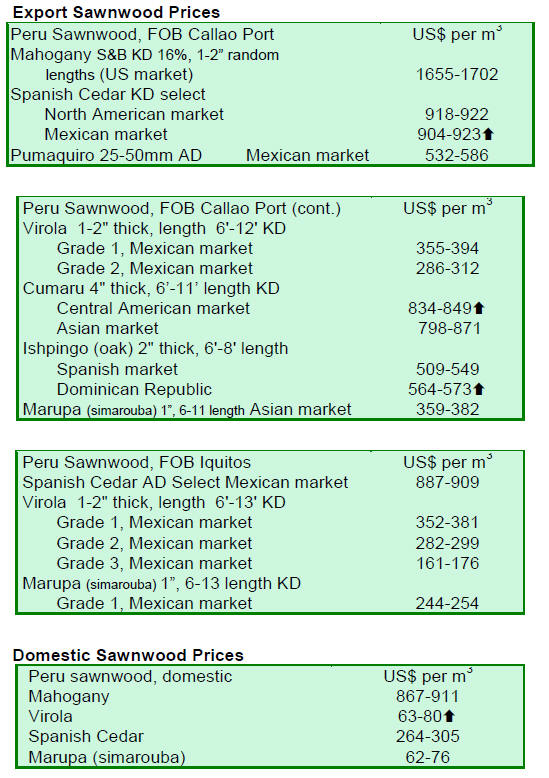
9.
GUYANA
Greenheart log prices give
up recent gains
During the period under review Greenheart log prices both
for the fair and small sawmill qualities gave up some of
the gains made earlier, there was no export of standard
sawmill quality for Greenheart logs.
Purpleheart log prices for fair and small sawmill
qualities
remains firm, while there was no export of the standard
sawmill quality of Purpleheart logs.
Mora log prices remained unchanged with the
exception of
small sawmill quality logs prices of which increased.
Demand in N. America and Caribbean sustaining
sawnwood prices
Sawnwood prices were encouraging and contributed
positively to total export earnings. Undressed Greenheart
(Prime) was exported earning improved price levels to
US$ 594 per cubic metre.
Undressed Greenheart (select) saw an increase in
prices at
the top of the range from US$ 740 to US$ 827 per cubic
metre. Undressed Greenheart (merchantable quality) also
achieved good price levels reaching as much as US$ 600
per cubic metre.
Undressed Purpleheart sawnwood saw price changes
for
both the select and merchantable qualities with Undressed
Purpleheart (merchantable) showing a notable increase in
its top-end price from US$ 594 to US$ 700 per cubic.
Undressed merchantable quality Mora secured an
increase
in price while prices for the other qualities (select and
sound) remain unchanged.
Dressed Greenheart prices were good on the export
market
for this fortnight, moving from US$ 818 to US$ 850 per
cubic metre. Similarly Dressed Purpleheart sawnwood
experienced an encouraging upward trend in price from
US$ 912 to US$ 954 per cubic metre.
Piles and posts were in demand and prices improved
with
post prices reaching as high as US$ 700 per cubic metre.
The main destination for these products was North
America and the Caribbean.
Welcome news as local plywood mill resumes production
Barama Company Limited has restarted plywood
production with the aim of getting output up to 2,400
cubic metres per month.
The Company has also committed itself to working
closely
with the government to ensure that they maintain
compliance with all forest sector policies and to the
objective of value-adding processing.
When the company announced the restart of
production
company representatives indicated that they had been
working hard to restore plywood production so as to be
able to re-employ the over 200 workers who had been
without work. The restart of this plywood factory will
have a positive impact on the country¡¯s housing drive and
for many businesses involved in house building.
Prior to the temporary closure, Barama was
producing
around 1,600 cubic metres per month but with the new
operation this should increase to 2,400 cubic metres per
month.
The resumption of plywood exports came at a time
when
demand was firm and good prices were secured with
BB/CC quality plywood prices having increased from US$
640 to US$ 690 per cubic metre.
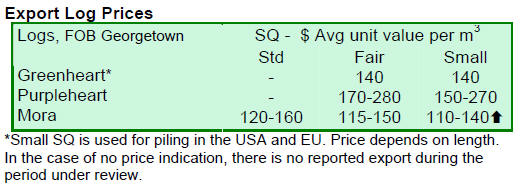
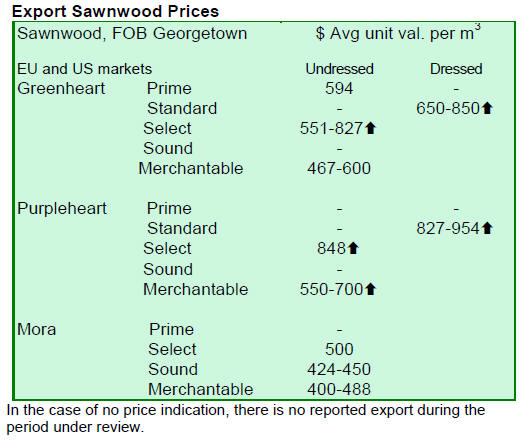
Related News:
¡¡